I am often asked, "What is different about what you teach? And why?"
Let me answer that question by analyzing a swing that Bobby Tewksbary has also analyzed. That way, you can easily see the similarities and differences in our beliefs and points of emphasis.
Bradley From CA Swing Analysis
When I look at this clip and swing, what I see is a youth swing that is well above average given his age and body geometry and that, with a few tweaks, will scale quite well as this hitter grows.
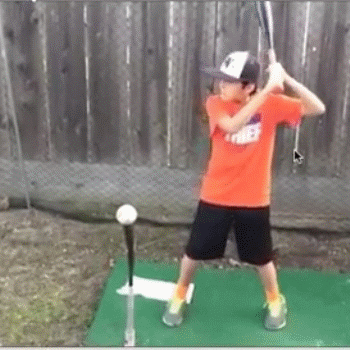
Bradley from CA
Tewks' Comments
The hitter's dad's comments about this swing are...
Hitter stays pretty compact. Weaknesses include lack of extension, less than ideal use of lower half, and hands tend to leak forward/down prior to planting with stride foot.
Yes, these are the dad's words. The problem is that Tewks agrees with them, even when they aren't accurate.

Bradley from CA
Hands Leaking Down/Forward
The height of the hands at set-up doesn't matter. It's largely cosmetic. What matters is where the hands are as the hitter goes into foot plant and their shoulders are about to rotate.
While Bradley's hands do drop a bit at the start of his swing and into foot plant, that drop stops once the front heel plants and the shoulders start to rotate. What's more, while the back elbow keeps dropping through the start of the swing, the hands drop initially but don't drop any lower than the back shoulder.
From foot plant on, the hands link up with and then rotate with the back shoulder.
Having said that, I would like to see a swing off of a lower pitch to see if he adjusts by dropping his hands farther. However, what I see in this clip isn't a problem.
Less than Ideal Use of Lower Half
The biggest problem I have with Tewks' comments is with what he says about the lower half starting at 2:26 and especially at 2:40.
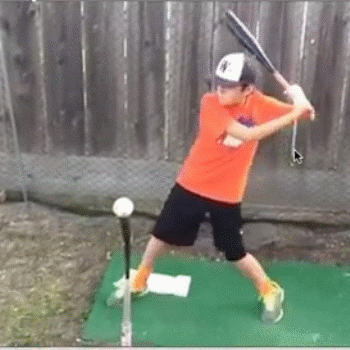
Bradley from CA
I describe the three stages of the lower body sequence in PC-C-P. Except for an issue with the front leg that I mention below, what I see in this hitter is a lower body that is entirely consistent with the High-Level Swing (and well above average).
Hip Flop
Tewks' comment that "there's not much drive going on" at 2:40 is simply wrong.
There is a lot of drive going on, and it's coming from the right place; the hitter's core and the quad of his right leg.
At this point in the swing, with the front foot down, what his back leg and foot do is ENTIRELY a function of what the hips and front leg do. The back leg has done its job; it is unweighted (which is why it often comes off the ground) and is being pulled around by the hips.
To use a aviation analogy, once the front foot plants and through the Point Of Contact, the back leg is like the landing gear on an aircraft while it's in flight; it's done its job and is just along for the ride.
To be honest, Tewks' comments about this hitter's hips and back leg remind me of this clip.
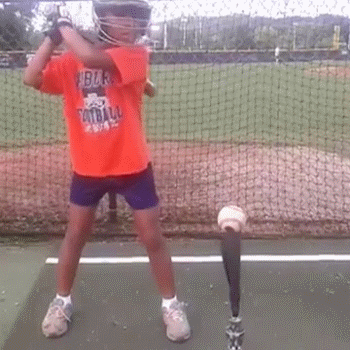
Crazy Back Leg
This clip was posted by a dad who had been told that his son's biggest issue was his lower body and, in particular, his "crazy" back leg. In fact, while his son's upper body needs some work -- there's some Bat Drag in there -- his son's lower body was easily the best part of his swing and is essentially perfect.
There's Not Much Drive Going On
Drive from where? Of what?
Bradley's hips are being driven by the -- imperfect as I mention below -- firing of his front leg, and his right quad and the extension of his right knee in particular, which is what you see in every high-level swing.
I know that some people think and teach that the hips are pushed open by the back leg, and that may be the root of Tewks' comment. However, that is not consistent with the swings of the best hitters, starting with Albert Pujols' swing.
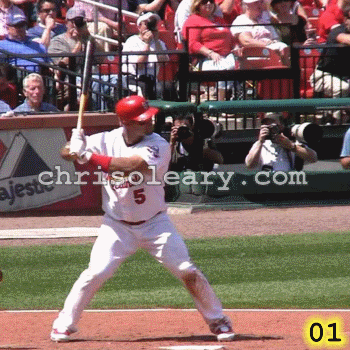
Albert Pujols
Also, notice how, as he goes into and through foot plant and contact, Albert Pujols' hips rotate much more around than up. Among other things, that keeps Albert Pujols' head from moving too much -- his head raises up at most an inch or two -- and lets him see the ball, and keeps the bat on plane with the ball, longer.
When I look at the clip below, and aside from what I mention below, I see the same fundamental movement pattern as in the Albert Pujols clip above.

Bradley from CA
In fact, Bradley's hip rotation reminds me of one of my favorite pics of Josh Donaldson.
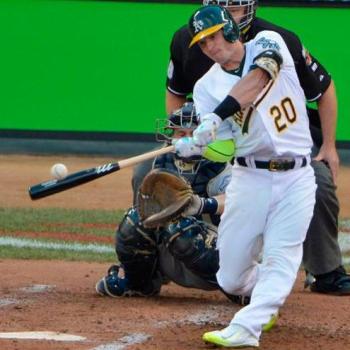
Josh Donaldson
Lack of Extension
First, extension is the effect of a good swing, not the cause of a good swing. As a result, I don't teach it and only use it for diagnostic purposes.
Second, because kids often swing proportionally lighter bats, they will often not achieve the same levels of extension that you see in major leaguers.
I will say that I do see something contradictory in this clip. His arm bar suggests that he is swinging, or has swung, a heavier bat. However, his lack of full extension suggests that the bat is lighter than a -3 (and/or that Bradley is quite strong).
I'd have to know more about the bat(s) to say more.
In general, and as I say in my Bat Sizing Guide, because of the problem of Bat Drag, it's better to err on the side of a lighter bat, not a heavier bat.
The Only Thing He Has Left is the Arms
In truth, Bradley's swing is a great example of the general principle of Momentum Transfer and the concept of Whip in particular.
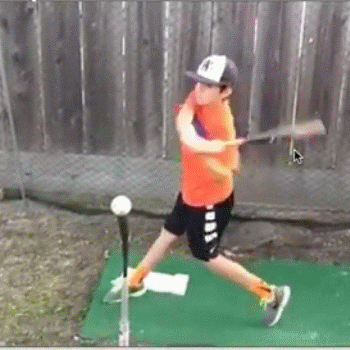
Bradley from CA
Some people call what you see in the clip above "throwing" the barrel but I prefer to use the term "releasing" the barrel.
Regardless, what the barrel does is the result of momentum being transferred from the body to the barrel.
In the clip above, while it looks like (just) the hands, wrists, and arms are in control, in truth the barrel is in control. Bradley's arms, hands, and wrists are just doing their darndest to hold onto the barrel and keep it from flying out toward the pitcher.
The hands and wrists don't work, they are worked.
By the barrel.
Heel Down Drill
If you follow me on Twitter @thepainguy and have seen my tweets about Evan Longoria in particular and the Back Foot in general, you know that I think it's important.
In fact, I am currently working with a major leaguer who needs to improve the consistency of his back foot.
However, having a hitter work on keeping their back heel down throughout the entire swing is inconsistent with what you see in the clip below of Albert Pujols. Yes, Albert Pujols' back heel starts and then stays down through the first part of his swing.
But then it pops up off the ground.
As does his entire back foot.
I don't see a significant, or problematic, difference in the timing or nature of the heel pop of Albert Pujols and Bradley.

Albert Pujols
In each case, the front foot plants and the back heel pops up.

Bradley from CA
I think any additional focus by Bradley on his back heel, and following Tewks' advice to do a drill in which you "Don’t let the rear heel come up at all during the swing" is far more likely to hurt his swing than help it.
It will turn his back foot into an anchor for his hips and cut short his hip rotation.
My View
I see a youth swing that is well above-average, given his age, and that holds up well in comparison to the swing of Bryce Harper.

Bryce Harper
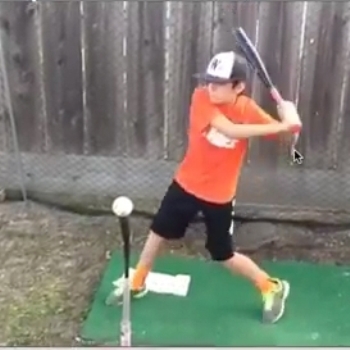
Bradley Frame 26
I only see a few significant differences between this two swings.
Front Knee Flexion at Foot Plant
This hitter's biggest issue -- and maybe his only issue that isn't just age and geometry-related -- is his front leg and, specifically, the angle of his front knee at foot plant.
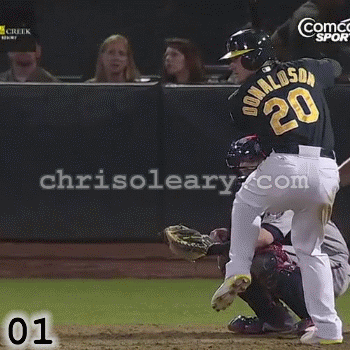
Josh Donaldson
Rather than landing with his front leg bent as Josh Donaldson does, which allows the extension of his front knee to finish the rotation of his hips, he lands with his front leg straight and almost locked out. As a result, Bradley isn't able to finish the rotation of his hips.

Albert Pujols
Albert Pujols is another hitter who had a superior lower body in his prime and whose swing I have studied in detail in my flipbooks, hitting webbooks, and DVDs, starting with my 2006 flipbook analysis of Albert Pujols' swing (Pujols7 clip).
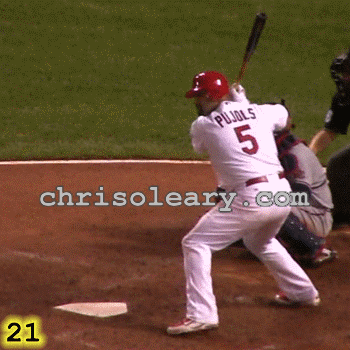
Albert Pujols
Without knowing what Bradley has been taught, it's hard to say why this is happening. However, and as with Brett Wallace, this could be due to his taking too long of a stride.
Arm Bar
What you are seeing are very typical youth geometries; long arms and narrow shoulders, which makes it hard to keep the front arm from barring out, especially if the bat is too heavy.
He has complete arm bar, which widens the radius of his swing. Look at how far his hands get outside of his back shoulder. As in a golf swing, this hitter's arm bar will maximize his bat speed. However, golf balls don't move and this hitter's arm bar will likely limit his X-Axis Adjustability.
Some will point to Griffey and say that arm bar is no big deal. However, Griffey was an incredibly gifted athlete and there's a reason why full arm bar, as Griffey had, is rare among good MLB hitters (but common among struggling MLB hitters). Few hitters can exhibit full arm bar and still adjust, especially to inside pitches (and keep them fair).
I should also mention that this tends to remain an issue in female fast-pitch softball players due to the typical female form (which tends to have narrower shoulders than males).
Barrel Angle
Bryce Harper's barrel is a bit more vertical at this point. This could be due to Bradley adjusting to the height of the pitch. However, it's something to keep an eye on because...
- If the barrel is too flat at foot plant, it can create a hole UP in the strike zone.
- If the barrel is too upright at foot plant, it can create a hole DOWN in the strike zone.
Again, I'd like to see a clip of Bradley hitting a pitch at the bottom of the strike zone in order to know if he's adjusting correctly.
Separation
One other thing that needs to be improved at some point is Bradley's Separation.

Bryce Harper
You can see this by comparing Bryce Harper and Bradley at foot plant.

Bradley Frame 26
Bradley clearly needs to be taught about Loading. However, I wouldn't work on this until he first deals with his Arm Bar.